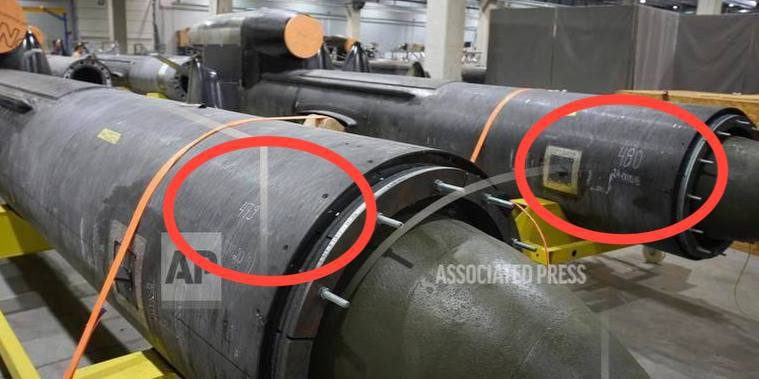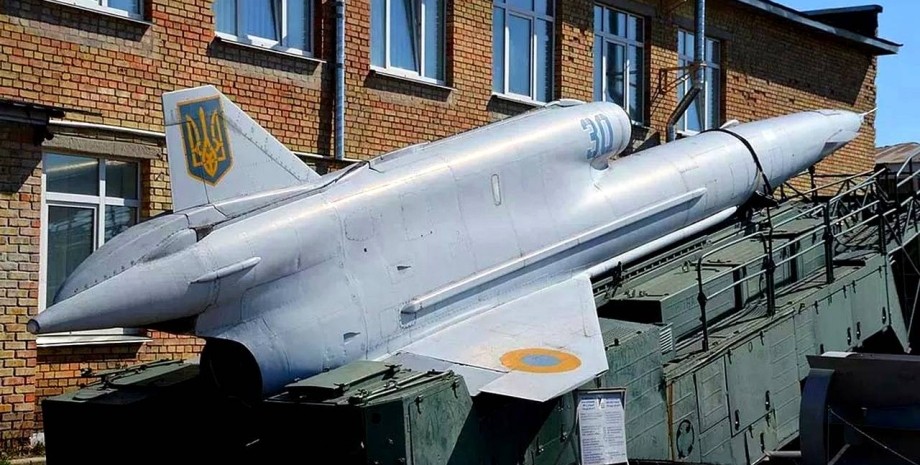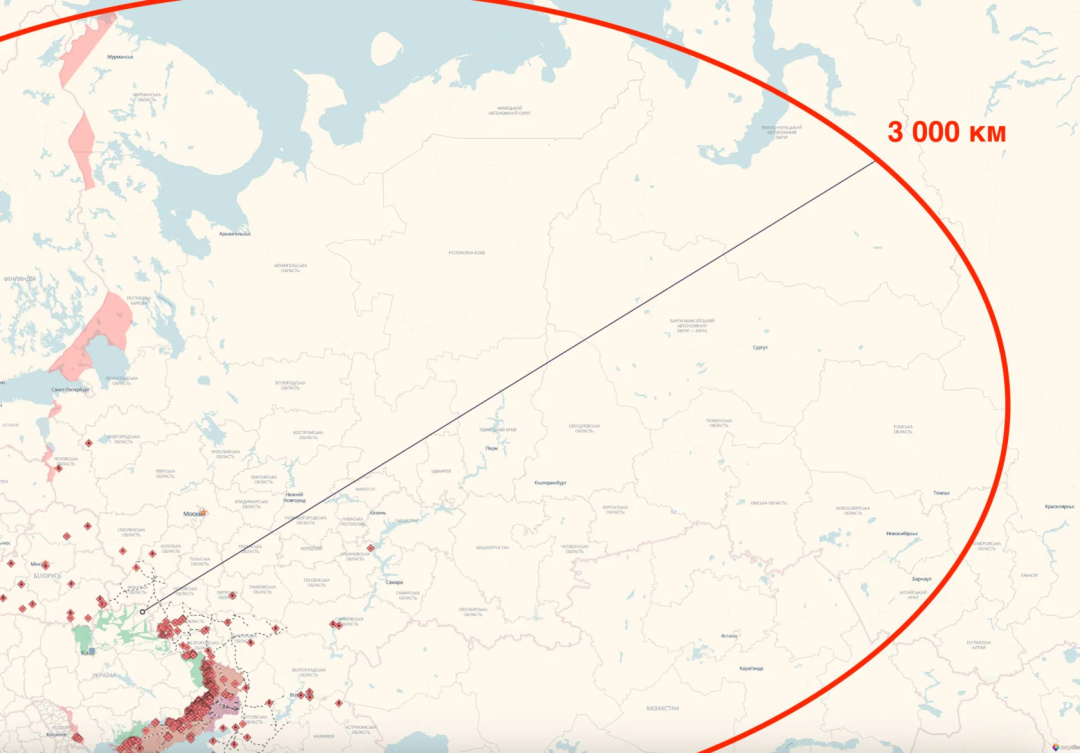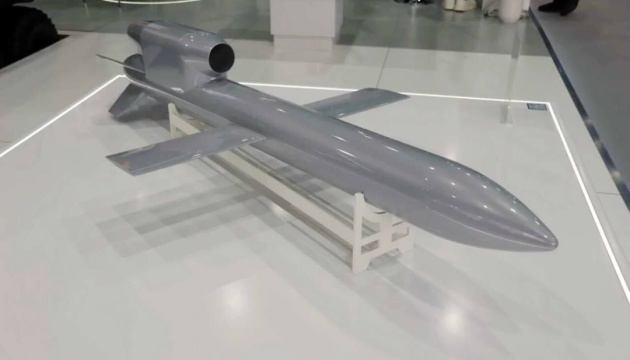The new Ukrainian missile can change the course of the war, and the fact that it is an “easy prey” for fighters is offset by deployment tactics and mass production
On the night of August 17, 2025, the Ukrainian information space exploded with news that instantly overshadowed all other developments except for the Oval Office meeting in the White House… The famous Ukrainian photojournalist Yefrem Lukatsky, who works for the Associated Press, published on Socials photos of new Ukrainian cruise missile exotically named “Flamingo”.
According to Lukatsky, this innovative weapon not just exists, but has already been put into quantity production, meaning it has succeeded through all trials and qualification process. The main sensation was the stated range of up to 1,864 miles (3,000 kilometers). This means a dramatic shift in the strategic landscape of the Russo-Ukrainian war, turning the Flamingo into a serious challenge for the Russian military industries located not only in the European part of the Russian Federation, but also in its more remote regions.
This news was later confirmed by officials: on August 18, the Ukraine Minister of Defense, Denys Shmyhal reported that Ukraine has developed a long-range and “very powerful” weapon, and President Volodymyr Zelensky, on August 21, said the Flamingo has succeeded through its trials program, calling it the most successful of all the missiles currently in Ukraine’s arsenal.
FLAMINGO UP CLOSE: OPERATING PARAMETERS, STRENGTHS AND WEAKNESSES
The new Ukrainian missile, as it quickly became clear, is a close relative to the FP-5 missile, which was showcased by Milanion Group at the IDEX 2025 defense exhibition in Abu Dhabi, the UAE, in early February 2025 (Milanion Group, headquartered in the United Arab Emirates, refers to itself as a British-Emirati defense and technology group, – ed.).
The outward similarity and identity of the stated operating parameters leave no doubt: the Flamingo and FP-5 are, most certainly, one and the same product. The manufacturer in Ukraine is the Fire Point company (experts suggest that both companies – Fire Point and Milanion Group – probably have “Ukrainian roots” either in terms of the management or in the project engineering team, – ed.) The new missile was named Flamingo due to the pink color of its initial version, journalists suggest.
Specifications and capabilities of the Flamingo / FP-5 missile look more than impressive:
Range: 1,864 miles (3,000 kilometers);
Warhead weight: 1,000 kg. (In a video published on August 21, the manufacturer claims it had increased the warhead weight to 1,150 kg);
Maximum take-off weight: 6,000 kg;
Maximum speed: 590 mph/950 km/h.
Cruising speed: 528-559 mph/850-900 km/h.
Wingspan: 6 meters.
Flight endurance: 4+ hours.
Guidance system: EW-resistant satellite navigation, inertial navigation.
Circular Error Probable (CEP): 14 meters.
When compared to the well-known Western cruise missiles Tomahawk and Storm Shadow, the Ukrainian-UAE creation provides several important advantages.
Range: the Flamingo, with its 3,000-kilometer range, can fly twice as far as the most recent upgrade to the Tomahawk Block V (over 1,600 kilometers) and several times further than the Storm Shadow (250–560 km).
Warhead: Flamingo’s 1-ton warhead is twice as powerful as counterparts seen in the Tomahawk and Storm Shadow missiles, which both have a weight of approx. 450 kg.
Speed and dimensions: Flamingo’s speed (up to 590 mph/950 km/h) is comparable to that of its Western counterparts. In terms of length (approx. 6 meters), it is similar to the Tomahawk, but has a significantly higher take-off weight – 6,000 kg versus 1.300 kg for its rivals.
[embedded content]
Representatives of the manufacturing company Fire Point do not hide their confidence in the superiority of the new missile. When asked whether Ukraine would be able to prevail in its war against the Russian Federation without U.S. support (particularly Tomahawk missiles) but with Flamingo missiles, the answer was unequivocal: “It would be, because Tomahawks, firstly, are outdated, and secondly, they are much inferior in terms of performance and capabilities. Flamingo surpasses them in every aspect. Thirdly, they are perhaps five times more expensive (one Tomahawk missile, depending on the modification, sells for 1.8 million to 4.25 million US dollars, so we can assume that one Flamingo is worth 360,00 to 850,000 US dollars – ed.), plus transportation and delivery expenses.” In their opinion, it is only domestic production that can provide the required number of missiles for use against the targets that Ukraine will choose independently.
STRENGTHS AND WEAKNESSES OF THE FLAMINGO MISSILE
The cruise missile FP-5 Flamingo has several important advantages: a warhead weighing 1,000 kg, a flight range of 3,000 km, and apparently a relatively simple design optimized for mass production. The manufacturer Milanion Group, during the missile’s presentation at IDEX-2025 in the UAE, reported a production rate of more than 50 FP-5 units per month, this achieved through a deliberate simplification of the design: the missile features straight non-folding wings and is launched from a ground-based platform rather than a transport/launch canister.
These choices reduce complexity but also mean the missile requires longer pre-launch preparations. The range and firepower, however, come at a cost. A missile that must carry enough fuel to fly 3,000 km inevitably grows in size.
Large dimensions: The FP-5 Flamingo has a take-off weight of 6 tons and a wingspan of 6 meters. The larger the missile, the more visible it is to enemy radars.
Lack of stealth technologies: To further simplify production, the FP-5 does not employ technologies to reduce radar observability. Low-altitude flight that can follow the curvature of the terrain can help bypass ground-based radars and air defenses, but airborne radars mounted on fighters have long been capable of detecting such targets against ground clutter. That being said, while lacking stealth is a drawback, it is not a critical one, otherwise such a missile would not have been created with such a range and warhead in the first place.
Long pre-launch preparation time: The missile will take from 20 to 40 minutes to go from stowed to ready-to-fire configuration. This is significantly longer compared to many current-generation counterparts, which increases the risk of the launcher being exposed and attacked.
Thus, the Flamingo is a weapon created according to the principle of “availability and effectiveness at the cost of technological sophistication.” Its effectiveness will depend on the deployment tactics and the ability to break through the enemy’s layered air defenses.

By the way, the Associated Press footage showed two missiles featuring side numbers 479 and 480, supposedly suggesting the number of the missiles (or at least airframes) produced.
A “MAP” FOR TRUMP: FLAMINGO’S GEOPOLITICAL DEBUT
The news about the new Ukrainian missile came in the context of another important event. Yefrem Lukatsky published his photos of Flamingo on August 17, and the very next day, on August 18, important negotiations between President Volodymyr Zelensky and his U.S. counterpart Donald Trump were to take place at the White House. Most military experts are unanimous that this coincidence was not accidental.
“Lukatsky’s message about the Flamingo missile does not look accidental… Its publication was probably timed to coincide with the summit in Washington. Ukraine has demonstrated that, even without direct support from the United States, we are capable of inflicting powerful and painful blows on Russia. This is a strong political signal to partners,” aviation expert Valeriy Romanenko said in a comment to Ukrinform.
This development became part of a broader strategy where military accomplishments and information campaigns are tightly integrated into the diplomatic process. Romanenko reminds that a similar practice has already been employed, for example, during the synchronization of military operations and negotiations in Istanbul. He mentioned as an example the Spiderweb Operation. “This is not just a battlefield, it is also a negotiations field, where every successful action or technological breakthrough strengthens our position in the international arena,” the expert added.
Oleksandr Kovalenko, defense columnist at the Information Resistance thinktank group, shares the conviction that the publication of photos of the highly sensitive facility was permitted from very high up. “We are not talking about a leak, but about a conscious signal aimed at strengthening President Zelensky’s negotiating position.” Experts are of the opinion that this step was intended to demonstrate to Trump and his inner circle that Ukraine has no intention of surrendering and has its own mighty capabilities to continue fighting, the ones that can reach targets as far as the Urals and even Siberia. During the previous meeting in February, Trump said Zelensky “did not have the cards”, but now Ukraine has another strong trump card to show to Trump.

Kovalenko notes with light irony that Trump himself may not have grasped the full significance of the news, but his entourage clearly got the signal: “It may be difficult for Donald Trump to embrace the geographical extent… But his advisers understand this well. And it is they who shape the U.S. vision of the Ukrainian position, after all.”
Thus, the Flamingo’s public debut became not just military-technological development, but also an important geopolitical development designed to strengthen Ukraine’s posture on the global stage.
THE MYSTERY OF BIRTH: TRIALS, MANUFACTURERS AND EXPERT EVALUATION
The surprise appearance of an ambitious project such as a 3,000-km range cruise missile raised natural questions: why weren’t there even rumors about it before, where and how were large-scale tests and trials conducted, and who is behind the manufacturing company?
Trials: calculations, circular routes and abroad testing ranges
One key question that raised was: how it was possible to test fly a 3,000-kilometer range missile in Ukraine, where such distances are physically absent. Experts offer several possible scenarios.
Valeriy Romanenko explains that the given range might be a parameter calculated based on the amount of fuel supply and its consumption by the engine. “We only know about the launch tests. The published videos show the solid-fuel booster lifting the missile into the air, after which the cruising engine is started. Launches with maximum take-off weight were probably also tested, but there is currently no evidence of test flies to the full range.”
At the same time, the expert does not rule out that full-fledged tests could have taken place outside Ukraine. “Since the FP-5 missile is associated with Milanion Group, the company that has a division in Saudi Arabia, it is quite possible that it was launched in the desert along a circular trajectory.” This method, according to Mr. Kovalenko, allows the actual range capability to be verified without the need to launch the missile to full range along a straight line. Technically, such tests on a closed route (hypothetically, the missile is launched from a site somewhere in Cherkasy region, flies to Chernivtsi and goes back and fro several times) are possible in Ukraine too.
Oleksandr Kovalenko adds that to verify the maximum range, there is no need to conduct tests over the full distance. “For this, data on fuel consumption at shorter distances – for example, 100, 500 or 1,000 kilometers would be enough. Having conducted several launches, in particular towards the territory of the Russian Federation, and having recorded the obtained parameters, you can determine the fuel consumption to range ratio. Based on this it is easy to calculate the maximum effective range.”
Manufacturers: Ukrainian Fire Point and its connection to the UAE
As mentioned above, the production of the Flamingo missile is the responsibility of the Ukrainian company Fire Point, which, according to media reports, was established at the beginning of the full-scale invasion with the aim of mass-producing affordable UAVs similar to the Iranian Shahed. The same company has designed and developed the FP-1 explosive drone that has already proven its high effectiveness, hitting targets deep behind enemy lines.
As regards the Flamingo, it is the product of close cooperation with the Milanion Group company from the UAE. The connection is seen from product code names: the missile is designated FP-5, while the drone from Fire Point is denoted as FP-1. Milanion Group has long-standing ties with Ukraine. Back in 2021, it signed a cooperation agreement with a major Ukrainian arms manufacturing company, and the company Ukrainian Armor became a dealer for Milanion Group’s AGEMA UGV 8×8 robotic platform that was later deployed to the battlefield by Kraken, a powerful and highly mobile special forces unit within the Main Intelligence Directorate (HUR) of Ukraine’s Ministry of Defense. Milanion Group’s British division is known as supplier of Alakran self-propelled mortars to Ukraine’s Armed Forces.
Asked about Ukraine’s share in developing this product, Valery Romanenko replied unequivocally: “Ukraine was undoubtedly the major designing contributor to this project. After all, Ukrainian specialists were the ones who drew up operational requirements and specifications document for the Flamingo, based on our needs and manufacturing capacities. If the design and development work were carried out exclusively by Western engineers, then all the missile components would be of Western production… we should rely as much as possible on our own production capacities, because only then will the project have prospects for quantity production.”
The small amount of publicly available information on Fire Point, according to the expert, is a justified security measure. “It is worth recalling the experience of our ballistic missile program: as soon as we publicly announced it was in development, the Russians immediately launched combination strikes targeting the entire technological chain… That is why excessive attention to detail can only do harm.”
Simple design optimized for mass production
Valeriy Romanenko considers the announced production rate of 50+ units per month to be quite realistic. This was made possible by a deliberate simplification of the design. “The Flamingo design is relatively simple, and it is this simplicity that makes it easier for industrial scaling.” The lack of a launch container, the use of a fixed wing instead of a folding wing, and a less sophisticated navigation system (inertial navigation with the periodic position and velocity updates from a Global Positioning System (GPS) receiver, probably without the use of a sophisticated terrain correlation system) all make production cheaper and faster. Alternatively, this complicates transportation and increases the time it takes for the missile to go from stowed to ready-to-fire configuration (up to 60 minutes). Such compromises allow for rapid scale-up of production. At the same time, as the expert emphasizes, simplicity does not necessarily mean low quality, and the missile apparently has a terminal guidance system that provides the required accuracy of the hit.
GENEALOGICAL TREE: STRIZH, V-1 OR AN ALL-NEW DESIGN?
The Flamingo’s unusual outer appearance – with the engine mounted above the airframe and fixed wings – has caused a wave of comparisons with historical weapons on social networks. Most often, the missile has been compared to the Soviet-designed tactical-operational reconnaissance drone Tu-141 Strizh and even to the German V-1 from the Second World War. Experts, however, urge not to draw hasty conclusions based on external similarities only.
Valery Romanenko categorically denies any connections to the Soviet UAV Strizh: ”The Flamingo missile has no relation to the Soviet Tu-141 drone. This is a completely different, classic design of a cruise missile.” He explains that mounting the engine above the airframe is an engineering solution that aims to simplify the design and save more internal volume for fuel and warhead. “Technically, it is easier to mount it above the airframe, thus releasing internal space for the solid-fuel booster, which is used for launch.”
Oleksandr Kovalenko elaborates further on this idea, drawing analogies with other types of aircraft. “Visually, the Tu-141 may indeed resemble the Flamingo. But in terms of its external outlines, it is also similar to the Su-35 or even the F-16. However, this does not make it the Su-35 or the F-16 at all. The same logic applies to the German WW II V-1 rocket of the 1944: yes, they share certain common features, but this does not mean that the V-1 can be identified with the Flamingo”.

According to Mr. Kovalenko, the concept of a cruise missile is universal: it will always have an airframe, wings, engine and guidance system. Just as cars or tanks of different eras share common features, so missiles retain the core design architecture. “Therefore, outward similarity is a natural and expected thing. But that’s where the similarity ends.” Kovalenko emphasizes that a weapon’s essence and value are determined not by the shape of the hull or airframe, but by its internal content: particularly specs and performance parameters, onboard electronic stuff, high-tech content, combat effectiveness and operational environment.”
Thus, despite a certain visual similarity to designs of the past, the Flamingo is a current-generation weapon designed to meet specific requirements in terms of maximum range and power while being optimized for quantity production.
ASYMMETRIC RESPONSE: TARGETS FOR FLAMINGO AND CHALLENGES EMERGING FOR RUSSIAN AIR DEFENSES
With its 3,000-kilometer range capability and a powerful 1,150 kg warhead, the Flamingo emerges as a weapon of strategic influence, capable of fundamentally changing the situation on Ukrainian battlefields and deep behind enemy lines. The missile’s range covers Russia’s European part to its full depth, and reaches to the Ural Mountains and even part of Siberia, including Moscow and St. Petersburg as well as big cities such as Yekaterinburg and Novosibirsk.
Priority targets: military-industrial and oil refining sectors
Experts are unanimous in the opinion that the prime targets for the Flamingo will be defense industrial facilities, as well as oil storage and refining industries in Russia.
Valery Romanenko paints a gloomy picture for Russia. According to him, it will not be just about damage, but about the complete destruction. “A powerful high-explosive warhead leaves a crater of up to 20 meters in diameter and a good depth upon exploding. This means that the roof and walls of the production hall collapse. Such a facility will be impossible to restore to its original state except for cleaning up the site and building everything from scratch.”
A similar fate, in his opinion, awaits Russian oil refineries. A successful strike on a crude distillation column turns it into a pile of scrap metal, and a simultaneous strike by several missiles can reduce the refinery to ruins. “The most prone to Flamingo attacks will be the largest oil refineries located in the European part of the Russian Federation, which are among the top ten: Ryazan (Russia’s third largest in terms of oil refining capacity), Kstovo in the Nizhny Novgorod region (4th), Yaroslavl (6th), Volgograd (7th), Perm (8th), Moscow (9th) and Tuapse (10th). All of them are within the Flamingo’s reach. And that’s to say nothing of smaller, but more closely located refineries… If attacks on these targets become systematic, the European part of Russia risks being left without fuel. Then supplies will have to be directed from Nizhnekamask or Omsk, meaning an additional thousands of kilometers of transportation, trains with fuel, which can also become targets of strikes in addition to railway hubs.

Arms manufacturing factories in Russia are under no less risk. The factories that manufacture Shakhed strike drones in Yelabuga and Izhevsk, enterprises producing cruise missiles and even the factory in Votkinsk – the only manufacturer of Oreshnik ballistic missiles — are reachable for the new Ukrainian missile. “As a result, up to 90 percent of Russian defense industries are at risk of coming under attack.”
Romanenko concludes that a strategic asymmetry has been created: “The Ukrainian rear areas that are unreachable for Russian attacks are protected by Europe, but Ukraine, for its part, obtains the capability to destroy virtually any defense-industrial facility on the Russian territory… this entails a fundamental change in the balance of power.”
Kostyantyn Kryvolap, an aviation expert, shares the view above: “If the Flamingo is made with a capability to reach and hit targets at the stated distance, the arms manufacturing enterprises in the European part of Russia can be destroyed.”
Pavlo Narozhnyi, a defense analyst and military volunteer activist, adds that one does not need oversophisticated guidance systems to target large facilities such as arms factories, and the key factor is the number and massiveness of strikes.
Prospects for Russian air defenses
That being said, the experts warn against excessive optimism, emphasizing that subsonic cruise missiles, to which the Flamingo belongs, are an easier target for air defenses than ballistic missiles. Russia has significant capabilities to counter them: a large number of air defense systems, long-range flying radars and MiG-31B fighters that are tailored specifically for this role. For example, a squadron of four such airplanes can monitor and control the airspace over a front up to 600 kilometers wide.
Valeriy Romanenko assumes that the Russians will be able to intercept a significant number of the missiles, hypothetically, four out of five missiles launched.
But what matters in this is that no air defense system guarantees 100% protection.
“Even if only five out of fifty missiles fired reach the target, this is enough to destroy at least three large Russian enterprises. And the consequences of such strikes will be critical for the enemy,” he added.
According to experts, the key to success will be the tactics of deploying these missiles. Combination attacks, where different purpose drones (strike drones, decoy targets, drone mockups) are used simultaneously with cruise missiles, can significantly overwhelm and break through even a dense air defense.
Oleksandr Kovalenko adds that the effectiveness of the interception will depend on the missile’s smartness – its ability to fly at ultra-low altitudes and follow the curvature of the terrain.
“Basically, the Russian air defense network comprises a sufficiently wide range of echeloned systems that are capable of intercepting missiles like the Flamingo –a subsonic cruise missile that does not offer any “unique” capabilities. However, the effectiveness of the interception will depend on many factors: the terrain being flown over, the missile’s flight altitude, the availability of electronic warfare countermeasures on board the missile to counter Russian air defense radars. The location of enemy forces and capabilities is also of importance: the more air defense systems are deployed in a specific federal district or region of the Russian Federation, the more effective interception will be. Because Russia’s problem is not only in the technological capabilities of its air defense network, but also in the availability of systems in numbers required to protect such a vast airspace,” the defense analyst argues.
Ukraine’s ballistic missile programs
Against the backdrop of the news about the Flamingo missile, the question of the Ukrainian ballistic missile program, information about which was to be announced at the end of this summer, has arisen again. There is little specific data available at the moment, but Oleksandr Kovalenko does not rule out that the Ukrainians are in for another surprise. “As for the Ukrainian ballistic missile program, the summer is not over yet, and it is quite possible that its official presentation will take place on Independence Day [to be celebrated on August 24]. This would be an appropriate media move – a symbolic and remarkable decision.”
CONCLUSION NOTES
The advent of the cruise missile like Flamingo is not just a new reinforcement to the Ukrainian Defense Forces. It is a development that marks the Ukrainian defense industry’s transition to a qualitatively new level of development and highlights a dramatic change in the strategic balance of power in the war. Having obtained a weapon capable of keeping up to 90 percent of Russia’s arms manufacturing capacities under threat, Ukraine obtains a powerful leverage to pressure on the aggressor country – militarily as well as politically.
Despite having certain drawbacks in terms of size and visual signature, Flamingo’s advantages – long range, heavy warhead and mass production potential – make it into a fearsome leverage in a war of attrition. With the Flamingo missile now available, Ukraine now is equipped to respond asymmetrically to Russian strikes, bringing the war home to the aggressor and further undermining its economic and warfighting capabilities.
Myroslav Liskovych, Kyiv
Source: Ukraine’s new cruise missile FP-5 Flamingo can reach 90 percent of Russian defense industries




